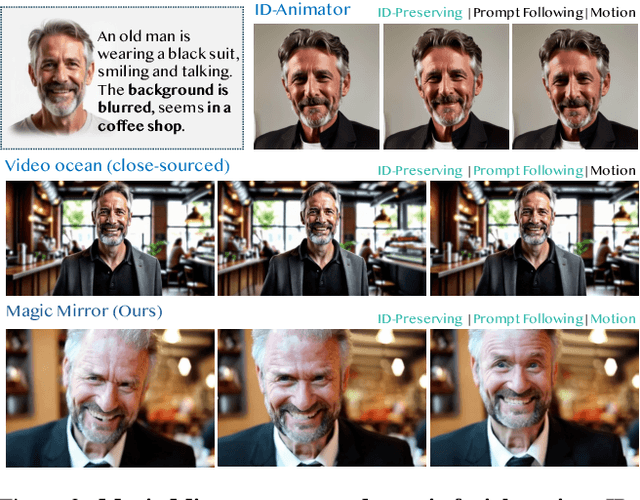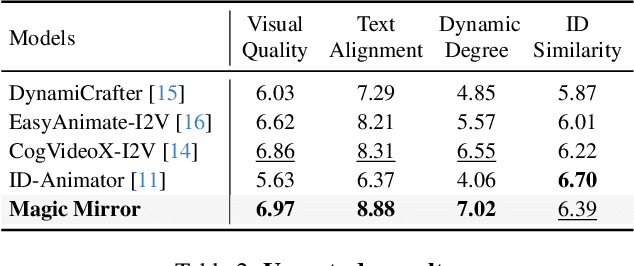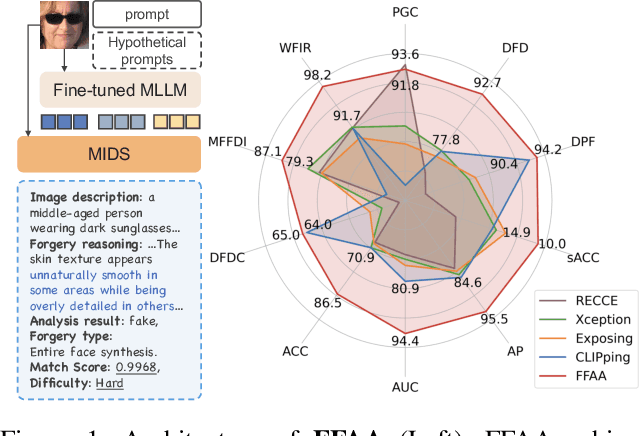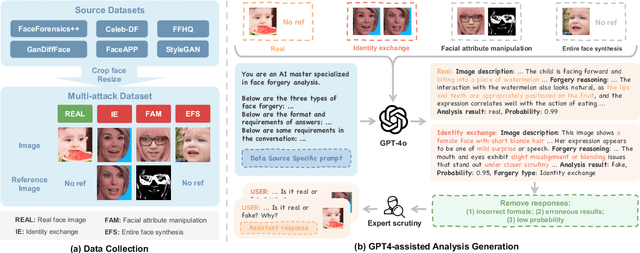Bin Xia
DreamVE: Unified Instruction-based Image and Video Editing
Aug 08, 2025Abstract:Instruction-based editing holds vast potential due to its simple and efficient interactive editing format. However, instruction-based editing, particularly for video, has been constrained by limited training data, hindering its practical application. To this end, we introduce DreamVE, a unified model for instruction-based image and video editing. Specifically, We propose a two-stage training strategy: first image editing, then video editing. This offers two main benefits: (1) Image data scales more easily, and models are more efficient to train, providing useful priors for faster and better video editing training. (2) Unifying image and video generation is natural and aligns with current trends. Moreover, we present comprehensive training data synthesis pipelines, including collage-based and generative model-based data synthesis. The collage-based data synthesis combines foreground objects and backgrounds to generate diverse editing data, such as object manipulation, background changes, and text modifications. It can easily generate billions of accurate, consistent, realistic, and diverse editing pairs. We pretrain DreamVE on extensive collage-based data to achieve strong performance in key editing types and enhance generalization and transfer capabilities. However, collage-based data lacks some attribute editing cases, leading to a relative drop in performance. In contrast, the generative model-based pipeline, despite being hard to scale up, offers flexibility in handling attribute editing cases. Therefore, we use generative model-based data to further fine-tune DreamVE. Besides, we design an efficient and powerful editing framework for DreamVE. We build on the SOTA T2V model and use a token concatenation with early drop approach to inject source image guidance, ensuring strong consistency and editability. The codes and models will be released.
Training-Free Efficient Video Generation via Dynamic Token Carving
May 22, 2025Abstract:Despite the remarkable generation quality of video Diffusion Transformer (DiT) models, their practical deployment is severely hindered by extensive computational requirements. This inefficiency stems from two key challenges: the quadratic complexity of self-attention with respect to token length and the multi-step nature of diffusion models. To address these limitations, we present Jenga, a novel inference pipeline that combines dynamic attention carving with progressive resolution generation. Our approach leverages two key insights: (1) early denoising steps do not require high-resolution latents, and (2) later steps do not require dense attention. Jenga introduces a block-wise attention mechanism that dynamically selects relevant token interactions using 3D space-filling curves, alongside a progressive resolution strategy that gradually increases latent resolution during generation. Experimental results demonstrate that Jenga achieves substantial speedups across multiple state-of-the-art video diffusion models while maintaining comparable generation quality (8.83$\times$ speedup with 0.01\% performance drop on VBench). As a plug-and-play solution, Jenga enables practical, high-quality video generation on modern hardware by reducing inference time from minutes to seconds -- without requiring model retraining. Code: https://github.com/dvlab-research/Jenga
GRADEO: Towards Human-Like Evaluation for Text-to-Video Generation via Multi-Step Reasoning
Mar 04, 2025Abstract:Recent great advances in video generation models have demonstrated their potential to produce high-quality videos, bringing challenges to effective evaluation. Unlike human evaluation, existing automated evaluation metrics lack high-level semantic understanding and reasoning capabilities for video, thus making them infeasible and unexplainable. To fill this gap, we curate GRADEO-Instruct, a multi-dimensional T2V evaluation instruction tuning dataset, including 3.3k videos from over 10 existing video generation models and multi-step reasoning assessments converted by 16k human annotations. We then introduce GRADEO, one of the first specifically designed video evaluation models, which grades AI-generated videos for explainable scores and assessments through multi-step reasoning. Experiments show that our method aligns better with human evaluations than existing methods. Furthermore, our benchmarking reveals that current video generation models struggle to produce content that aligns with human reasoning and complex real-world scenarios. The models, datasets, and codes will be released soon.
DiffStereo: High-Frequency Aware Diffusion Model for Stereo Image Restoration
Jan 17, 2025Abstract:Diffusion models (DMs) have achieved promising performance in image restoration but haven't been explored for stereo images. The application of DM in stereo image restoration is confronted with a series of challenges. The need to reconstruct two images exacerbates DM's computational cost. Additionally, existing latent DMs usually focus on semantic information and remove high-frequency details as redundancy during latent compression, which is precisely what matters for image restoration. To address the above problems, we propose a high-frequency aware diffusion model, DiffStereo for stereo image restoration as the first attempt at DM in this domain. Specifically, DiffStereo first learns latent high-frequency representations (LHFR) of HQ images. DM is then trained in the learned space to estimate LHFR for stereo images, which are fused into a transformer-based stereo image restoration network providing beneficial high-frequency information of corresponding HQ images. The resolution of LHFR is kept the same as input images, which preserves the inherent texture from distortion. And the compression in channels alleviates the computational burden of DM. Furthermore, we devise a position encoding scheme when integrating the LHFR into the restoration network, enabling distinctive guidance in different depths of the restoration network. Comprehensive experiments verify that by combining generative DM and transformer, DiffStereo achieves both higher reconstruction accuracy and better perceptual quality on stereo super-resolution, deblurring, and low-light enhancement compared with state-of-the-art methods.
Magic Mirror: ID-Preserved Video Generation in Video Diffusion Transformers
Jan 07, 2025



Abstract:We present Magic Mirror, a framework for generating identity-preserved videos with cinematic-level quality and dynamic motion. While recent advances in video diffusion models have shown impressive capabilities in text-to-video generation, maintaining consistent identity while producing natural motion remains challenging. Previous methods either require person-specific fine-tuning or struggle to balance identity preservation with motion diversity. Built upon Video Diffusion Transformers, our method introduces three key components: (1) a dual-branch facial feature extractor that captures both identity and structural features, (2) a lightweight cross-modal adapter with Conditioned Adaptive Normalization for efficient identity integration, and (3) a two-stage training strategy combining synthetic identity pairs with video data. Extensive experiments demonstrate that Magic Mirror effectively balances identity consistency with natural motion, outperforming existing methods across multiple metrics while requiring minimal parameters added. The code and model will be made publicly available at: https://github.com/dvlab-research/MagicMirror/
DreamOmni: Unified Image Generation and Editing
Dec 22, 2024Abstract:Currently, the success of large language models (LLMs) illustrates that a unified multitasking approach can significantly enhance model usability, streamline deployment, and foster synergistic benefits across different tasks. However, in computer vision, while text-to-image (T2I) models have significantly improved generation quality through scaling up, their framework design did not initially consider how to unify with downstream tasks, such as various types of editing. To address this, we introduce DreamOmni, a unified model for image generation and editing. We begin by analyzing existing frameworks and the requirements of downstream tasks, proposing a unified framework that integrates both T2I models and various editing tasks. Furthermore, another key challenge is the efficient creation of high-quality editing data, particularly for instruction-based and drag-based editing. To this end, we develop a synthetic data pipeline using sticker-like elements to synthesize accurate, high-quality datasets efficiently, which enables editing data scaling up for unified model training. For training, DreamOmni jointly trains T2I generation and downstream tasks. T2I training enhances the model's understanding of specific concepts and improves generation quality, while editing training helps the model grasp the nuances of the editing task. This collaboration significantly boosts editing performance. Extensive experiments confirm the effectiveness of DreamOmni. The code and model will be released.
FFAA: Multimodal Large Language Model based Explainable Open-World Face Forgery Analysis Assistant
Aug 19, 2024



Abstract:The rapid advancement of deepfake technologies has sparked widespread public concern, particularly as face forgery poses a serious threat to public information security. However, the unknown and diverse forgery techniques, varied facial features and complex environmental factors pose significant challenges for face forgery analysis. Existing datasets lack descriptions of these aspects, making it difficult for models to distinguish between real and forged faces using only visual information amid various confounding factors. In addition, existing methods do not yield user-friendly and explainable results, complicating the understanding of the model's decision-making process. To address these challenges, we introduce a novel Open-World Face Forgery Analysis VQA (OW-FFA-VQA) task and the corresponding benchmark. To tackle this task, we first establish a dataset featuring a diverse collection of real and forged face images with essential descriptions and reliable forgery reasoning. Base on this dataset, we introduce FFAA: Face Forgery Analysis Assistant, consisting of a fine-tuned Multimodal Large Language Model (MLLM) and Multi-answer Intelligent Decision System (MIDS). By integrating hypothetical prompts with MIDS, the impact of fuzzy classification boundaries is effectively mitigated, enhancing the model's robustness. Extensive experiments demonstrate that our method not only provides user-friendly explainable results but also significantly boosts accuracy and robustness compared to previous methods.
Fluid-Antenna Enhanced ISAC: Joint Antenna Positioning and Dual-Functional Beamforming Design under Perfect and Imperfect CSI
Jul 25, 2024Abstract:Integrated sensing and communication (ISAC) emerges as an essential technique for overcoming spectrum congestion. However, the performance of traditional ISAC systems with fixed-position-antennas (FPA) is limited due to insufficient spatial degree of freedom (DoF) exploration. Recently, fluid antenna (FA) with reconfigurable antenna position is developed to enhance the sensing and communication performance by reshaping the channel. This paper investigates an FA-enhanced ISAC system where a base station is equipped with multiple FAs to communicate with multiple single-antenna users and with FPAs to sense a point target. In this paper, we consider both perfect and imperfect channel state information (CSI) of the communication channel and sensing channel. In two cases, we focus on the maximization of the sensing signal-to-noise (SNR) by optimizing the positions of FAs and the dual-functional beamforming under the constraints of the FA moving region, the minimum FA distance and the minimum signal-to-interference-plus-noise (SINR) per user. Specifically, for the ideal case of perfect CSI, an iterative alternating optimization (AO) algorithm is proposed to tackle the formulated problem where the dual-functional beamforming and the FA positions are obtained via semidefinite relaxation (SDR) and successive convex approximation (SCA) techniques. Then, for the imperfect CSI case, we propose an AO-based iterative algorithm where $\mathcal{S}-$Procedure and SCA are applied to obtain the dual-functional beamforming and the FA positions. Furthermore, we analytically and numerically prove the convergence of the proposed algorithms. Numerical results demonstrate the notable gains of the proposed algorithms in the respective cases.
GaussianSR: High Fidelity 2D Gaussian Splatting for Arbitrary-Scale Image Super-Resolution
Jul 25, 2024Abstract:Implicit neural representations (INRs) have significantly advanced the field of arbitrary-scale super-resolution (ASSR) of images. Most existing INR-based ASSR networks first extract features from the given low-resolution image using an encoder, and then render the super-resolved result via a multi-layer perceptron decoder. Although these approaches have shown promising results, their performance is constrained by the limited representation ability of discrete latent codes in the encoded features. In this paper, we propose a novel ASSR method named GaussianSR that overcomes this limitation through 2D Gaussian Splatting (2DGS). Unlike traditional methods that treat pixels as discrete points, GaussianSR represents each pixel as a continuous Gaussian field. The encoded features are simultaneously refined and upsampled by rendering the mutually stacked Gaussian fields. As a result, long-range dependencies are established to enhance representation ability. In addition, a classifier is developed to dynamically assign Gaussian kernels to all pixels to further improve flexibility. All components of GaussianSR (i.e., encoder, classifier, Gaussian kernels, and decoder) are jointly learned end-to-end. Experiments demonstrate that GaussianSR achieves superior ASSR performance with fewer parameters than existing methods while enjoying interpretable and content-aware feature aggregations.
Fluid-Antenna Enhanced Integrated Sensing and Communication: Joint Antenna Positioning and Beamforming Design
Jul 07, 2024



Abstract:This paper investigates a fluid antenna (FA) enhanced integrated sensing and communication (ISAC) system consisting of a base station (BS), multiple single-antenna communication users, and one point target, where the BS is equipped with FAs to enhance both the communication and sensing performance. First, we formulate a problem that maximizes the radar signal-to-noise ratio (SNR) by jointly optimizing the FAs' positions and transmit beamforming matrix. Then, to tackle this highly non-convex problem, we present efficient algorithms by using alternating optimization (AO), successive convex approximation (SCA), and semi-definite relaxation (SDR). Numerical results demonstrate the convergence behavior and effectiveness of the proposed algorithm.
 Add to Chrome
Add to Chrome Add to Firefox
Add to Firefox Add to Edge
Add to Edge